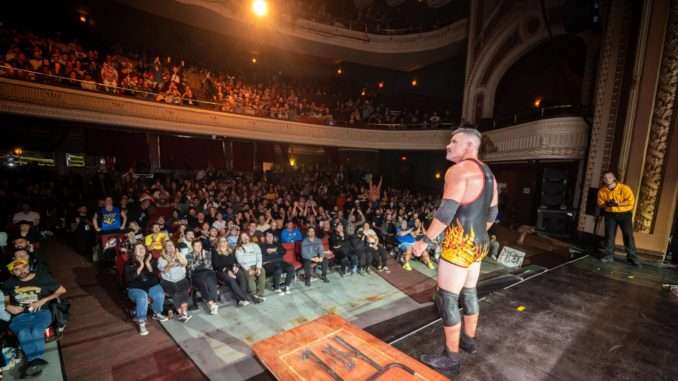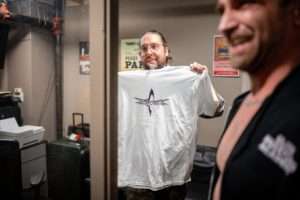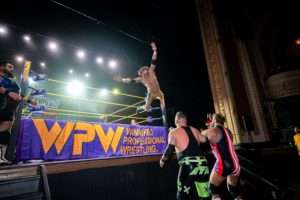
On a Thursday evening in October, three levels of seating were full of rabid fans waiting to see some of their favorites wrestle. Backstage, some wondered if the nosebleed seats wouldn’t get a good enough view of the ring. “Tell them they should have bought tickets earlier!” a voice replied in jest.
In an attempt to help these not-so-early-bird fans, a pair of projectors were set up on the walls, providing a broadcast of the event.
This wasn’t the makings of a taping for popular television programs Monday Night Raw or Friday Night Smackdown, nor was it a stand-out show from a competitor brand like AEW or TNA. It was a homegrown product born in a Central Canadian city: Winnipeg Pro Wrestling (WPW).
Despite just launching back in 2018—and having basically a third of its existence feature no events due to the COVID-19 pandemic—WPW has become a booming promotion on the Canadian independent scene. The company quickly grew an organic, local fanbase and created a brand sustainable enough to house monthly shows. It is, as some would say, a “hot” territory.
Last month the promotion presented “Rumble In The Burt,” a card in the city’s famous Burton Cummings Theatre. The more than 100-year-old venue is most often utilized by full-time musicians with national or even international fame, or travelling stand-up comics. It’s one of the more iconic venues in the city, and in 1991 was designated as one of the “National Historic Sites of Canada.”
Until 2023, the roughly 1,600-capacity venue was not an annual destination for professional wrestling. However, as a testament to WPW’s success, last month was the local brand’s second time hosting a card at the venue. They drew over 1,000 on their first trip to the location, and recent estimates from WrestleTix saw their latest show grow by a couple hundred more fans.
WPW has cultivated a diehard audience, with loyalists ranging from lifelong wrestling diehards to those who have never tuned into a weekly program from the industry. The promotion’s success is getting them close to selling out landmark venues in the city and turning local up-and-comers into microcelebrities. It has quickly become one of the more interesting stories emerging from the Canadian professional wrestling scene.
From bars to ‘The Burt’

WPW wasn’t initially intended to be the household local wrestling name that it has become nowadays. Co-owners Devin Bray and Ben Kissock initially planned to simply host four shows a year inside a small local bar. For Bray, a social services worker of over a decade, it was a way to escape from his day-to-day roles.
“During WPW I managed a homeless shelter and a housing program,” he said during an interview backstage at the promotion’s October show. “My day job and life is very full of crisis and overdose responses and crazy stuff like that. But wrestling is the ultimate escape for anyone, I think. It’s such a beautiful thing … WPW is the easy part.”
The first shows were a vibe that Bray nostalgically looks back upon, with the promotion running a more “intense” and “sweaty” product inside the infamous Sherbrook Inn, a notorious small bar in the city. While they held smaller shows, notable out-of-market names were still booked: Winnipeg-based talents brushed shoulders with names like Ethan Page and Shotzi, for example.
“That’s where the family started, and I think a lot of people romanticized that era and miss it,” he said. The location, which was a fixture in the community for 60 years, abruptly closed in February.
The small-time vibe that WPW initially pursued ended up being just a short period of the promotion’s history. After five events at the Sherbrook Inn, the COVID-19 pandemic forced them to stop running events for over two years. By the time WPW returned in early 2022, they realized the 350-fan West End Cultural Centre was a better venue to run. “It’s easy in the West End,” Bray remembers thinking.
From then on, WPW’s expansion was rapid. The promotion started to run more events: Five shows a year turned into eight shows. Crowd sizes went from 300 and change to over 500 on select shows with even bigger venues. Visions of two-night tournaments and big projects came around. Then last year, an opportunity to run The Burton Cummings Theatre emerged. One idea after another, it was all a success for WPW. Things weren’t slowing down.
WPW’s sudden evolution has been tough for its owners to process, as they are too busy keeping the momentum going. “It’s hard to stop and smell the roses,” Bray said.
Spending just some time backstage before their latest event, it’s easy to believe that Bray doesn’t have time to soak it all in. Like any independent promotion, the owners wear many hats. Bray ran laps around the venue as the show neared, writing and then re-writing the results due to a last-minute scratch.
He graciously provided POST Wrestling with an interview backstage at the Burton Cummings Theatre show last month, with the chat only stopping because, along with press relations, booking, merchandising, and writing, Bray also served as a caretaker for out-of-town talent. Former WWE talent Mustafa Ali walked into Bray’s coffin-sized office backstage at “The Burt,” wondering where he could set up his suitcase for the evening. I wasn’t told the interview was over, per se, but I knew that Ali’s time was probably more valuable than mine.
‘Storylines are what is driving us right now’

If WWE has Wrestlemania and AEW has All In, “Rumble In The Burt” was WPW’s big show. The promotion had numerous major storylines coming to a close that evening, many of which were months in the making. It’s what keeps the core audience coming back, Bray believes.
“The storylines are what is driving us right now … Every match has a story. I’ve got magazines,” Bray said, referring to the multi-page programs handed out at each event. “The reason that exists is so people come in understanding what’s going on.”
Bray explained that the local wrestlers could consistently show up at their shows, making it easy to book the type of long-term programs they aimed to write.
In and around the Burton Cummings Theatre, the larger-than-usual WPW crowd undoubtedly had many in attendance to see the promotion’s top storylines finally pay off.
Sure, some hadn’t attended a WPW event before and had likely been more drawn in by larger names on the card like Ali and Matt Cardona. But some fans who spoke to POST Wrestling admitted they didn’t even watch that much wrestling outside of WPW. Along with the international wrestling stars, numerous locals were mentioned as the names fans most looked forward to seeing: Sammy Peppers, Bobby Schink, and AJ Sanchez among the pack.
If you had a question about Winnipeg’s professional wrestling scene, Sanchez would probably be one of the best to ask. The 38-year-old has spent more than half of his life wrestling, with most of his bouts taking place inside the province of Manitoba.
Sanchez described Winnipeg’s fanbase as a “very eccentric and eclectic group.” More specifically, he found an interesting dynamic at play during WPW shows: Along with the diehard wrestling fans who will attend any show under the sun, they attracted attendees who were on the opposite side of wrestling fandom.
“I think we’ve done a great job of appealing to people who aren’t regular wrestling fans,” Sanchez said.
Sanchez played a role in one of the biggest storyline payoffs of the night. Once a rotten heel who created turmoil for fan favorite Bobby Schink, the rivals hoped to coexist and take down a cutthroat faction backed by WPW’s on-screen General Manager, James Korba. They went up against Anderson Tyson Moore and Danny Duggan, who, despite being Canadian, was able to convincingly enrage the crowd with an American patriot gimmick.
Sanchez suffered a two-on-one beatdown early in the match, as Schink seemingly wasn’t able to hit the ring. Was Schink not able to muster up the courage to team with a man who had done so much damage to his career before? Was this some elaborate plan to force Sanchez to suffer a beatdown? The fans started to become restless about the situation. But, it was all to build up to a massive pop when Schink came charging to the ring to even the odds.
Schink was a house on fire, taking out Moore and Duggan. At one point he came flying off the stage—a six-or-so-foot drop—to land on his opponents. In one of the most iconic venues in his hometown, Schink had more than 1,000 fans in the palm of his hand. The audience was going wild for Schink. They knew his odd maple syrup gimmick, and one fan had a sign for him hanging from the rafters. If it was your first day in town, you might have thought Schink was an ex-WWE talent who had never touched down in Winnipeg before.
As WPW continues to grow, its owners seek bigger goals than before

By the end of the night, reviews from fans around the venue were positive. The night’s most memorable moments unanimously went to the main event, which saw James Roth defeat Tyler Colton in a rematch to earn the WPW Championship. Roth and Colton pushed themselves hard in the epic headliner, doing a table spot off the stage and ripping apart the ring before the finish. Fans came with different levels of exposure to wrestling, but they all provided the same testimony in interviews with POST: They would definitely attend another WPW show.
“Rumble In The Burt” was a show that signified how far WPW has come, attracting an attendance figure rarely seen for an independent-level event. Despite in the beginning eyeing the goal of just hosting bar shows, Bray and Kissock now looked at much more loftier hopes for the promotion.
“Before, I would say it was [for] a free t-shirt every show because I like our t-shirts a lot,” co-owner Bray said, reflecting on what initially motivated him to run WPW. “Now, I think we’re building a legacy within pro wrestling by putting Winnipeg on the map … I would love to pass down a legacy of WPW running for f****** 50 years.”
Backstage, Kissock was satisfied with the growth in attendance for WPW, but simply continuing to run “The Burt” wasn’t enough for him. Next year, he hoped, they would return for a sell-out.
Schink, who earlier in the day was nervous and struggling to stomach meals, was relaxed and reminiscing about the atmosphere after the show: “Just an energy unlike anything I’ve ever felt before,” he said. “This crowd was insane.”
The event was Schink’s biggest match ever. Before then, his biggest was, well, the Burton Cummings Theatre show that came before it. As he was describing the emotions of the night, he had to stop himself: A door flew open, and all heads in the bustling lobby turned in one direction.
Locals roared: It wasn’t an international wrestling superstar, but instead the hometown hero, WPW Champion Roth.
“Champ! Champ! Champ!” Schink chanted, in unison with the dozens who stuck around after the show. “That’s what it’s all about right there.”
